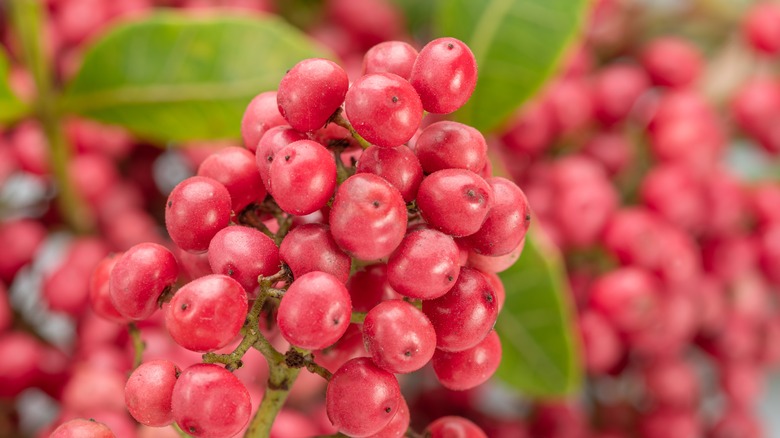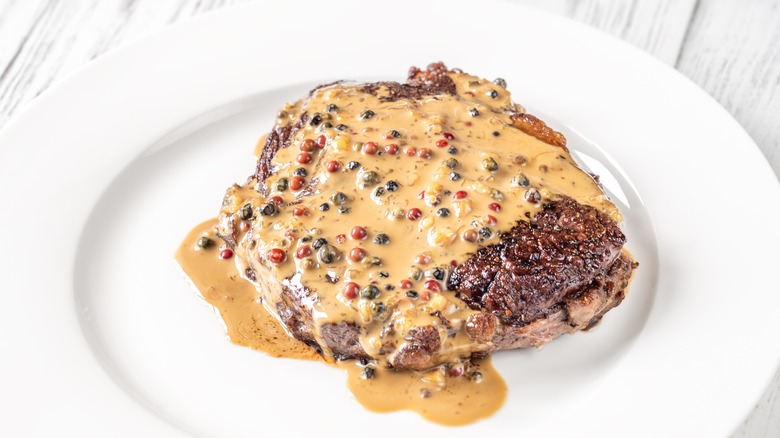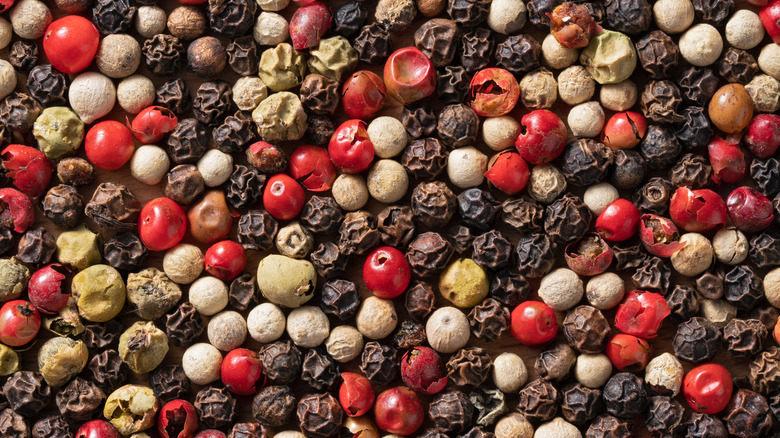How Pink Peppercorns Are Different From All The Rest
We may receive a commission on purchases made from links.
Pepper is one of those culinary staples that we take for granted. It's called for in most savory dishes and sits on every kitchen counter and restaurant table. It's always there, and we tend to forget about the importance of those black pebble-like balls of peppercorn. It's also always easy to forget that there are different types of peppercorns, including white, green, and pink.
Despite the name, pink peppercorns aren't actually related to the other types of peppercorns. These small, vibrant pink berries come from two different species, the Schinus molle (native to Peru) and Schinus terebinthifolius (native to Brazil), while on the other hand, true peppercorns like black, white, or green all come from the Piper nigrum plant. Interestingly, despite a similar appearance and shape to peppercorns, pink peppercorns are more closely related to cashews or pistachios. True peppercorns have a denser, more solid structure, while pink peppercorns are lighter, slightly hollow, and have a thin outer skin.
The bright pink color sets pink peppercorns apart, as well as their flavor profile. The pink berry has a very light pepper flavor, but it doesn't contain a key compound, piperine, which gives the other peppercorns that signature pungency and bite. Instead, pink peppercorns contain a compound called pinene, which gives it a citrusy, pine-like smell. Compared to other peppercorns, they have a brighter flavor, with floral, sweet, and fruity notes and a mild level of spiciness.
How to use pink peppercorn in the kitchen
Pink peppercorn is more versatile than other varieties because of its use in both sweet and savory applications. It works well to lighten up heavier animal-based proteins such as beef and lamb, perfect as a garnish or in spice rubs and marinades. The more delicate flavor is a natural pairing for seafood, such as salmon, scallops, and shrimp. Slightly spicy and floral flavors make for a great vinaigrette for salad and vegetable-based dishes. Crushed, the bright pink flakes are a beautiful way to bring color to any dish, especially on top of hummus, pasta, rice, and creamy soups.
In desserts, it's a surprising flavor and color for elevating white chocolate or plain vanilla ice cream. Pink peppercorns can complement the flavors of berry or citrus-flavored pies, tarts, and panna cottas. Complexity can be added to buttercream frosting for cakes and cupcakes with the addition of the pink berries. Peppercorns have their place in cocktails too; they can be used to make a flavored simple syrup, or crushed and mixed into a gin or vodka drink with citrus and herbal flavors.
Pink peppercorns are popular in French cuisine, where they are called rose poivre. One of the most popular dishes that uses pink peppercorn is a peppercorn sauce that is generously poured over steak or a cut of lamb. The spice is also used throughout South America, where it is native, and it can also be found in Moroccan and Asian cuisine.
Where to find pink peppercorns
While pink peppercorns sound exotic, it's likely you've seen them before in a peppercorn mix. These peppercorn blends are relatively common in standard supermarkets and are easy to find online, and contain a mix of green, black, white, and pink peppercorns. Pink peppercorns sold on their own are not as common in supermarkets, but can also be purchased online, for around $8 for a 4-ounce bag. The spice can be purchased in its whole berry form and then filled into a pepper mill or grinder — like other peppercorn, freshly ground pepper is best.
It's also not very common to see a grinder of pink peppercorn sitting on a restaurant table either; you may spy it in a peppercorn mix, but this pink version is mostly reserved for fine dining restaurants that use it for a vibrant garnish, or restaurants that serve French and Moroccan cuisine where this ingredient is more commonplace. One reason this ingredient is not so prevalent in the average restaurant is due to the fact it is a sneaky allergen — because it is not a true peppercorn, this berry is considered to be apart of the tree nut family, which is dangerous for many people with food allergies.
If you live in the states of California, Arizona, Florida, or Texas, you may have seen pink peppercorns without realizing it. Here, the two varieties of pink peppercorn trees are grown ornamentally, so you can go out and harvest some yourself!


